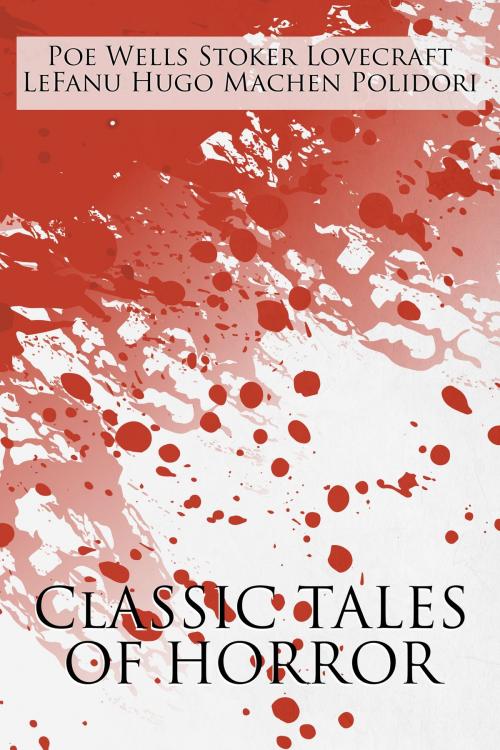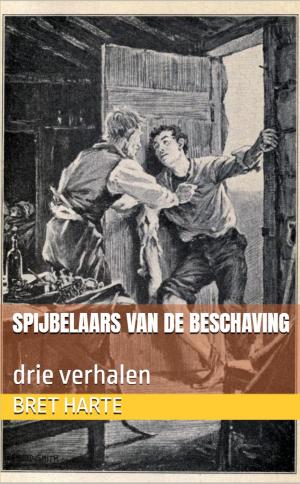Classic Tales of Horror
A Collection of the Greatest Horror Tales of All-Time: At the Mountains of Madness, Carmilla, The Great God Pan, The Hunchback of Notre Dame, The Invisible Man, The Lair of the White Worm, The Masque of the Red Death, The Vampyre
Fiction & Literature, Anthologies, Horror, Classics| Author: | H. P. Lovecraft, J. Sheridan Le Fanu, Arthur Machen, Victor Hugo, H. G. Wells, Bram Stoker, Edgar Allan Poe, John William Polidori | ISBN: | 1230002271460 |
| Publisher: | Castanea Classics | Publication: | April 14, 2018 |
| Imprint: | Language: | English |
| Author: | H. P. Lovecraft, J. Sheridan Le Fanu, Arthur Machen, Victor Hugo, H. G. Wells, Bram Stoker, Edgar Allan Poe, John William Polidori |
| ISBN: | 1230002271460 |
| Publisher: | Castanea Classics |
| Publication: | April 14, 2018 |
| Imprint: | |
| Language: | English |
Ranging from the macabre to the supernatural, the collection of stories found in Classic Tales of Horror contains some of the most influential horror and dark fiction books of all-time.
Included in this classic horror anthology are:
- At the Mountains of Madness by H. P. Lovecraft
- The Lair of the White Worm by Bram Stoker
- Carmilla by J. Sheridan LeFanu
- The Great God Pan by Arthur Machen
- The Hunchback of Notre Dame by Victor Hugo
- The Invisible Man by H. G. Wells
- The Masque of the Red Death by Edgar Allan Poe
- The Vampyre by John William Polidori
A bit more about each book:
At the Mountains of Madness by H. P. Lovecraft recounts the events of a disastrous expedition to the Antarctic continent in September 1930, as well as what was found there by a group of explorers led by the narrator, Dr. William Dyer of Miskatonic University.
Carmilla is a Gothic novella by Joseph Sheridan Le Fanu and is one of the early works of vampire fiction, predating Bram Stoker's Dracula (1897) by 26 years.
The Lair of the White Worm by Bram Stoker is based on the legend of the Lambton Worm. The plot focuses on Adam Salton, originally from Australia, who is contacted by his great-uncle, Richard Salton, in 1860 Derbyshire for the purpose of establishing a relationship between these last two members of the family. His great-uncle wants to make Adam his heir. Adam travels to Richard Salton's house in Mercia, Lesser Hill, and quickly finds himself at the centre of mysterious and inexplicable occurrences.
The Great God Pan by Arthur Machen relates the tragic events after the main character Clarke bears witness to a strange experiment performed by his friend, Dr. Raymond. The ultimate goal of the doctor is to open the mind of man so that he may experience the spiritual world, an experience he calls "seeing the great god Pan". He performs the experiment, which involves minor brain surgery, on a young woman named Mary. She awakens from the operation awed and terrified but quickly becomes "a hopeless idiot". Years later, as the story unfolds, Clarke learns that mysterious happenings and disappearances are related to this experiment.
The Hunchback of Notre-Dame (French: Notre-Dame de Paris, "Our Lady of Paris") is a French Romantic/Gothic novel by Victor Hugo, published in 1831. The original French title refers to Notre Dame Cathedral, on which the story is centered along with the tragic story of Quasimodo who has fallen in love with the beautiful gypsy Esmeralda.
The Invisible Man is a science fiction novel by H. G. Wells that tells the story of Griffin, a scientist who has devoted himself to research into optics and invents a way to change a body's refractive index to that of air so that it neither absorbs nor reflects light and thus becomes invisible. Griffin successfully carries out this procedure on himself, but fails in his attempt to reverse it. An enthusiast of random and irresponsible violence, Griffin, as the invisible man, has become an iconic character in horror fiction.
The Masque of the Red Death by Edgar Allan Poe follows Prince Prospero's attempts to avoid a dangerous plague, known as the Red Death, by hiding in his abbey. He, along with many other wealthy nobles, hosts a masquerade ball within seven rooms of the abbey. In the midst of their revelry, a mysterious figure disguised as a Red Death victim enters and makes his way through each of the rooms bringing death to Prospero's door.
The Vampyre is often viewed as the progenitor of the romantic vampire genre of fantasy fiction and was described by Christopher Frayling as "the first story successfully to fuse the disparate elements of vampirism into a coherent literary genre."
Ranging from the macabre to the supernatural, the collection of stories found in Classic Tales of Horror contains some of the most influential horror and dark fiction books of all-time.
Included in this classic horror anthology are:
- At the Mountains of Madness by H. P. Lovecraft
- The Lair of the White Worm by Bram Stoker
- Carmilla by J. Sheridan LeFanu
- The Great God Pan by Arthur Machen
- The Hunchback of Notre Dame by Victor Hugo
- The Invisible Man by H. G. Wells
- The Masque of the Red Death by Edgar Allan Poe
- The Vampyre by John William Polidori
A bit more about each book:
At the Mountains of Madness by H. P. Lovecraft recounts the events of a disastrous expedition to the Antarctic continent in September 1930, as well as what was found there by a group of explorers led by the narrator, Dr. William Dyer of Miskatonic University.
Carmilla is a Gothic novella by Joseph Sheridan Le Fanu and is one of the early works of vampire fiction, predating Bram Stoker's Dracula (1897) by 26 years.
The Lair of the White Worm by Bram Stoker is based on the legend of the Lambton Worm. The plot focuses on Adam Salton, originally from Australia, who is contacted by his great-uncle, Richard Salton, in 1860 Derbyshire for the purpose of establishing a relationship between these last two members of the family. His great-uncle wants to make Adam his heir. Adam travels to Richard Salton's house in Mercia, Lesser Hill, and quickly finds himself at the centre of mysterious and inexplicable occurrences.
The Great God Pan by Arthur Machen relates the tragic events after the main character Clarke bears witness to a strange experiment performed by his friend, Dr. Raymond. The ultimate goal of the doctor is to open the mind of man so that he may experience the spiritual world, an experience he calls "seeing the great god Pan". He performs the experiment, which involves minor brain surgery, on a young woman named Mary. She awakens from the operation awed and terrified but quickly becomes "a hopeless idiot". Years later, as the story unfolds, Clarke learns that mysterious happenings and disappearances are related to this experiment.
The Hunchback of Notre-Dame (French: Notre-Dame de Paris, "Our Lady of Paris") is a French Romantic/Gothic novel by Victor Hugo, published in 1831. The original French title refers to Notre Dame Cathedral, on which the story is centered along with the tragic story of Quasimodo who has fallen in love with the beautiful gypsy Esmeralda.
The Invisible Man is a science fiction novel by H. G. Wells that tells the story of Griffin, a scientist who has devoted himself to research into optics and invents a way to change a body's refractive index to that of air so that it neither absorbs nor reflects light and thus becomes invisible. Griffin successfully carries out this procedure on himself, but fails in his attempt to reverse it. An enthusiast of random and irresponsible violence, Griffin, as the invisible man, has become an iconic character in horror fiction.
The Masque of the Red Death by Edgar Allan Poe follows Prince Prospero's attempts to avoid a dangerous plague, known as the Red Death, by hiding in his abbey. He, along with many other wealthy nobles, hosts a masquerade ball within seven rooms of the abbey. In the midst of their revelry, a mysterious figure disguised as a Red Death victim enters and makes his way through each of the rooms bringing death to Prospero's door.
The Vampyre is often viewed as the progenitor of the romantic vampire genre of fantasy fiction and was described by Christopher Frayling as "the first story successfully to fuse the disparate elements of vampirism into a coherent literary genre."















